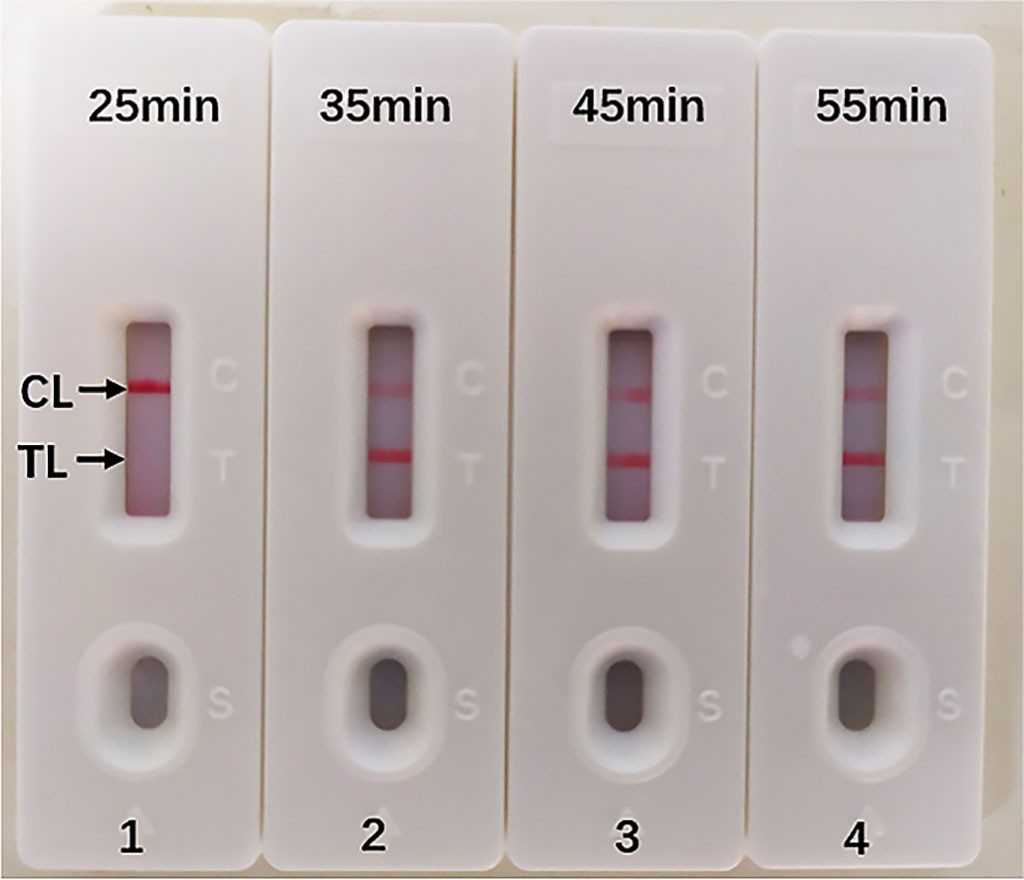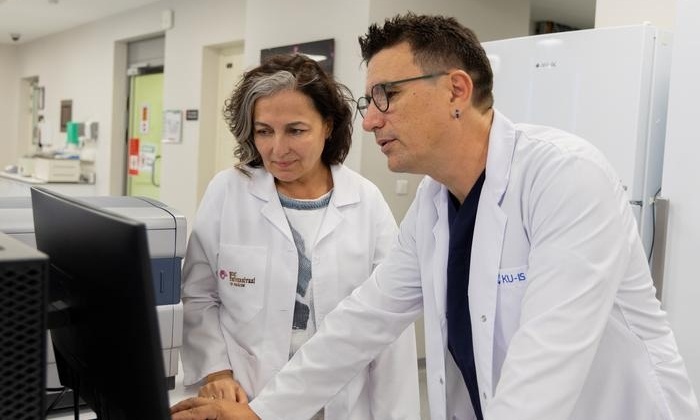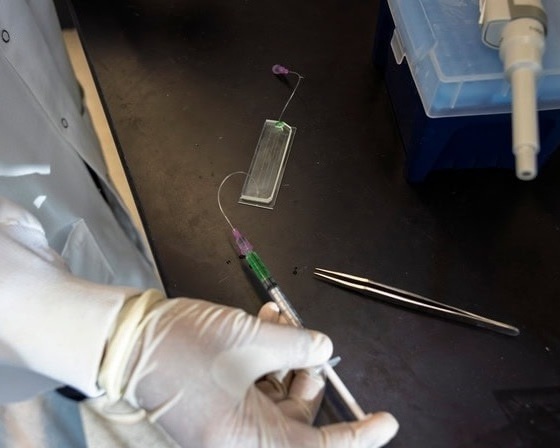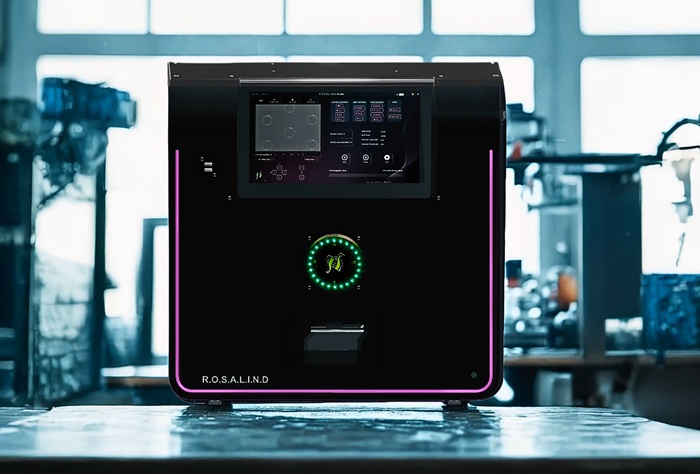MCDA-LFB Assay Developed for Rapid Detection of Legionnaires’ Disease
|
By LabMedica International staff writers Posted on 18 Jan 2022 |

Image: Optimized reaction time for Multiple Cross Displacement Amplification (MCDA-LFB) assay to detect Legionella pneumophila. The best sensitivity was seen when the amplification lasted for 35 minutes (Photo courtesy of Zhejiang Provincial People’s Hospital)
Legionella pneumophila is an opportunistic waterborne pathogen of significant public health problems, which can cause serious human respiratory diseases (Legionnaires’ disease). Legionnaires’ disease is characterized by severe lung infection symptoms, including severe pneumonia with a high fatality rate.
Diagnostic methods, including traditional bacterial culture methods, serological testing, urine antigen detection and nucleic acid amplification techniques, have been developed and used to detect Legionnaires’ disease. Multiple cross displacement amplification (MCDA), a novel isothermal nucleic acid amplification technique, has been applied in detecting many bacterial agents.
Respiratory Medicine Specialists at the Zhejiang Provincial People’s Hospital (Hangzhou; People’s Republic of China) developed a MCDA coupled with Nanoparticles-based Lateral Flow Biosensor (MCDA-LFB) for the rapid detection of L. pneumophila. A total of 40 bacterial strains were used in this assay, including 24 strains of L. pneumophila and 16 strains of non-L. pneumophila. The team used traditional bacterial culture method, conventional PCR detection and MCDA-LFB method to test 88 specimens suspected of L. pneumophila. A set of 10 primers based on the L. pneumophila specific mip gene to specifically identify 10 different target sequence regions of L. pneumophila was designed.
The optimal time and temperature for amplification are 57 minutes and 65 °C. The limit of detection (LoD) is 10 fg in pure cultures of L. pneumophila. No cross-reaction was obtained and the specificity of MCDA-LFB assay was 100%. The whole process of the assay, including 20 minutes of DNA preparation, 35 minutes of L. pneumophila-MCDA reaction, and 2 minutes of sensor strip reaction, took a less than 1 hour. Among 88 specimens for clinical evaluation, five (5.68%) samples were L. pneumophila-positive by MCDA-LFB and traditional culture method, while four (4.55%) samples were L. pneumophila-positive by PCR method targeting mip gene. Compared with culture method, the diagnostic accuracy of MCDA-LFB method was higher.
The authors concluded that the L. pneumophila-MCDA-LFB method they successfully developed is a simple, fast, reliable, and sensitive diagnostic tool, which can be widely used for the identification of L. pneumophila in basic and clinical laboratories. The study was published on January 8, 2022 in the journal BMC Microbiology.
Related Links:
Zhejiang Provincial People’s Hospital
Diagnostic methods, including traditional bacterial culture methods, serological testing, urine antigen detection and nucleic acid amplification techniques, have been developed and used to detect Legionnaires’ disease. Multiple cross displacement amplification (MCDA), a novel isothermal nucleic acid amplification technique, has been applied in detecting many bacterial agents.
Respiratory Medicine Specialists at the Zhejiang Provincial People’s Hospital (Hangzhou; People’s Republic of China) developed a MCDA coupled with Nanoparticles-based Lateral Flow Biosensor (MCDA-LFB) for the rapid detection of L. pneumophila. A total of 40 bacterial strains were used in this assay, including 24 strains of L. pneumophila and 16 strains of non-L. pneumophila. The team used traditional bacterial culture method, conventional PCR detection and MCDA-LFB method to test 88 specimens suspected of L. pneumophila. A set of 10 primers based on the L. pneumophila specific mip gene to specifically identify 10 different target sequence regions of L. pneumophila was designed.
The optimal time and temperature for amplification are 57 minutes and 65 °C. The limit of detection (LoD) is 10 fg in pure cultures of L. pneumophila. No cross-reaction was obtained and the specificity of MCDA-LFB assay was 100%. The whole process of the assay, including 20 minutes of DNA preparation, 35 minutes of L. pneumophila-MCDA reaction, and 2 minutes of sensor strip reaction, took a less than 1 hour. Among 88 specimens for clinical evaluation, five (5.68%) samples were L. pneumophila-positive by MCDA-LFB and traditional culture method, while four (4.55%) samples were L. pneumophila-positive by PCR method targeting mip gene. Compared with culture method, the diagnostic accuracy of MCDA-LFB method was higher.
The authors concluded that the L. pneumophila-MCDA-LFB method they successfully developed is a simple, fast, reliable, and sensitive diagnostic tool, which can be widely used for the identification of L. pneumophila in basic and clinical laboratories. The study was published on January 8, 2022 in the journal BMC Microbiology.
Related Links:
Zhejiang Provincial People’s Hospital
Latest Technology News
- Diagnostic Chip Monitors Chemotherapy Effectiveness for Brain Cancer
- Machine Learning Models Diagnose ALS Earlier Through Blood Biomarkers
- Artificial Intelligence Model Could Accelerate Rare Disease Diagnosis
- AI Saliva Sensor Enables Early Detection of Head and Neck Cancer
- AI-Powered Biosensor Technology to Enable Breath Test for Lung Cancer Detection
- AI Model Achieves Breakthrough Accuracy in Ovarian Cancer Detection
- Portable Biosensor Diagnoses Psychiatric Disorders Using Saliva Samples
- Cell-Sorting Device Uses Electromagnetic Levitation to Precisely Direct Cell Movement

- Embedded GPU Platform Enables Rapid Blood Profiling for POC Diagnostics
- Viral Biosensor Test Simultaneously Detects Hepatitis and HIV
Channels
Clinical Chemistry
view channel
Noninvasive Blood-Glucose Monitoring to Replace Finger Pricks for Diabetics
People with diabetes often need to measure their blood glucose multiple times a day, most commonly through finger-prick blood tests or implanted sensors. These methods can be painful, inconvenient, and... Read more
POC Breath Diagnostic System to Detect Pneumonia-Causing Pathogens
Pseudomonas aeruginosa is a major cause of hospital-acquired and ventilator-associated pneumonia, particularly in lung transplant recipients and patients with structural lung disease. Its ability to form... Read moreMolecular Diagnostics
view channel
World's First NGS-Based Diagnostic Platform Fully Automates Sample-To-Result Process Within Single Device
Rapid point-of-need diagnostics are of critical need, especially in the areas of infectious disease and cancer testing and monitoring. Now, a direct-from-specimen platform that performs genomic analysis... Read more
Rapid Diagnostic Breakthrough Simultaneously Detects Resistance and Virulence in Klebsiella Pneumoniae
Antibiotic resistance is a steadily escalating threat to global healthcare, making common infections harder to treat and increasing the risk of severe complications. One of the most concerning pathogens... Read moreHematology
view channel
MRD Tests Could Predict Survival in Leukemia Patients
Acute myeloid leukemia is an aggressive blood cancer that disrupts normal blood cell production and often relapses even after intensive treatment. Clinicians currently lack early, reliable markers to predict... Read more
Platelet Activity Blood Test in Middle Age Could Identify Early Alzheimer’s Risk
Early detection of Alzheimer’s disease remains one of the biggest unmet needs in neurology, particularly because the biological changes underlying the disorder begin decades before memory symptoms appear.... Read more
Microvesicles Measurement Could Detect Vascular Injury in Sickle Cell Disease Patients
Assessing disease severity in sickle cell disease (SCD) remains challenging, especially when trying to predict hemolysis, vascular injury, and risk of complications such as vaso-occlusive crises.... Read more
ADLM’s New Coagulation Testing Guidance to Improve Care for Patients on Blood Thinners
Direct oral anticoagulants (DOACs) are one of the most common types of blood thinners. Patients take them to prevent a host of complications that could arise from blood clotting, including stroke, deep... Read moreImmunology
view channel
Blood Test Could Identify Colon Cancer Patients to Benefit from NSAIDs
Colon cancer remains a major cause of cancer-related illness, with many patients facing relapse even after surgery and chemotherapy. Up to 40% of people with stage III disease experience recurrence, highlighting... Read moreBlood Test Could Detect Adverse Immunotherapy Effects
Immune checkpoint inhibitors have transformed cancer treatment, but they can also trigger serious immune-related adverse events that damage healthy organs and may become life-threatening if not detected early.... Read morePathology
view channel
AI Tool Simultaneously Identifies Genetic Mutations and Disease Type
Interpreting genetic test results remains a major challenge in modern medicine, particularly for rare and complex diseases. While existing tools can indicate whether a genetic mutation is harmful, they... Read more
Rapid Low-Cost Tests Can Prevent Child Deaths from Contaminated Medicinal Syrups
Medicinal syrups contaminated with toxic chemicals have caused the deaths of hundreds of children worldwide, exposing a critical gap in how these products are tested before reaching patients.... Read more
Tumor Signals in Saliva and Blood Enable Non-Invasive Monitoring of Head and Neck Cancer
Head and neck cancers are among the most aggressive malignancies worldwide, with nearly 900,000 new cases diagnosed each year. Monitoring these cancers for recurrence or relapse typically relies on tissue... Read moreTechnology
view channel
Diagnostic Chip Monitors Chemotherapy Effectiveness for Brain Cancer
Glioblastoma is one of the most aggressive and fatal brain cancers, with most patients surviving less than two years after diagnosis. Treatment is particularly challenging because the tumor infiltrates... Read more
Machine Learning Models Diagnose ALS Earlier Through Blood Biomarkers
Amyotrophic lateral sclerosis (ALS) is a rapidly progressive neurodegenerative disease that is notoriously difficult to diagnose in its early stages. Early symptoms often overlap with other neurological... Read moreIndustry
view channel
BD and Penn Institute Collaborate to Advance Immunotherapy through Flow Cytometry
BD (Becton, Dickinson and Company, Franklin Lakes, NJ, USA) has entered into a strategic collaboration with the Institute for Immunology and Immune Health (I3H, Philadelphia, PA, USA) at the University... Read more






















